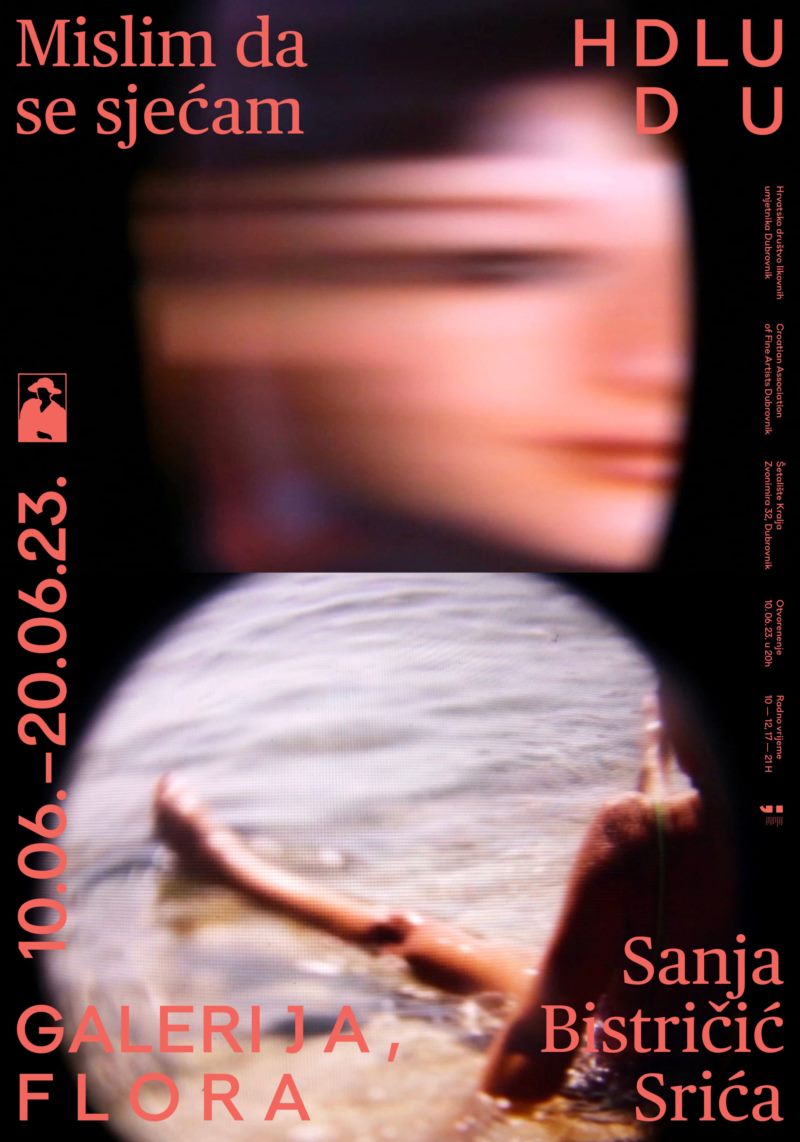Sanja Bistrić Srića - Memory, Fragment, Dream
Gallery Flora 8pm

Memory, Fragment, Dream
Is there such a thing as an undoubtedly true memory? To what extent are ourmemories (un)consciously constructed autofictions? Chantal Akerman saidthat while talking about our memories we should address them as our ownimaginary truth, keeping in mind their deceptive yet constitutional nature. In hermnemonic research I Think I Remember Sanja Bistričić employs the documentaryexperimentalfilm language and explores image, sound, and memory fragmentsin diaristic form. In her influential book Ordinary Affects anthropologist KathleenStewart emphasizes the affective dimension of everyday life. Seemingly prosaicevents and ordinary affects hide extraordinary intensities, tensions and relationswhich can bring to the fore subtle insights into “socialities, identities, dreamworlds, bodily states and public feelings of all kinds.” For Bistričić the quotidian iscomposed of intertwined fragments, and so-called ordinary moments experiencedwith extraordinary sensory intensity compose the fabric of her artistic endeavour.The authoress presents her “imaginary” familial memory archive which sheconstantly re-fragments, de-constructs, and obscures. There is a discrepancybetween she who remembers and her collected memories, and as a result hypnoticand sensual in-between-spaces and in-between-times flourish taking us on a timetravelof sorts – from present to past, from past to present, but also potential future.Her flashing and oneiric world functions according to the principle of fluidityand blending. Through diaristic form she simultaneously uncovers and concealsintimate details form her life in which the image is dominant, spontaneous, andpoetic. Memory is always a gap between experience and revision while the filmrecording itself also slowly fades and dissolves. It is as if she employs varioustechniques, like mirroring, magnification, and multiplication, to consciouslykeep her memories at a distance. Perhaps she doesn’t want to become a creatureendowed with total recall like Marker’s Sandor Krasna – a time-traveller who haslost the ability to forget and consequently carries with him all past misfortunes.Being aware that images he records ultimately become memory-surrogates Krasnainstead choses to make lists of things that make his heart beat faster.Sanja also makes lists of things that make her heart beat faster – like blackDoc Martens shoes with 14 holes, the kiwi her mother brought to the hospital, abouquet of yellow daffodils stolen from someone else’s garden, or rabbits jumpingin front of her dad’s car in the middle of the insular night. Her image-memoriesalmost exclusively come from early childhood, and they unfold like small shocks ofbeauty – simultaneously funny and unnerving, invigorating and traumatic – linkedtogether by an intensity we lose once we get older. Dreamy Bistričić approachesher memories in a playful manner subverting Bergson’s distinction between“pure memory” (virtual image) and various mental images (image-souvenirs,dreams, or daydreams). For her memories are “expanded emotions that allowus to manipulate time so that we are simultaneously situated in the here andnow, in the past and in the future.” Her playfulness is also manifested in theway she approaches “her imaginary truth” – she juxtaposes her memories withthe memories of other family members thus opening the space for differentinterpretations.Bistričić started her research process with pure documentation – recordingrandom events, encounters with family and friends, and various spontaneoussituations. She was encouraged to do so when she realised, she has hardly anyfamily photos and video-materials. In this digital and technologically advanced erait is as if her family does not exist at all. She decided that the poetic-documentaryvisuals she recorded will not represent actual moments from the present butmoments which took place long ago (for instance from childhood years) whichshe revives and re-creates. Through visual-virtual and narrative interpretationshe replaces the actual-present with memories which thus become actual againbut in constant dialogue with the past. Elliptical memory thus comes to the fore,perennially flowing and renewing itself. To create “her own imaginary truth”Bistričić superposes the written word fragment on the image fragment – sentenceswhich she semantically transforms and graphically shapes into short poetryfragments. Exploration of image leads her to textual exploration, while textleads her to sound. Through audio-collage she connects all the images into onedreamy entity. Again, she uses multiple techniques like mini-compositions, loops,noises, frequencies, field recording, and through narration and singing, her voice.Attempting to unite the memory fragments she additionally multiples them andembraces her artistic vision of memory as a “dreamy form.”Dina Pokrajac